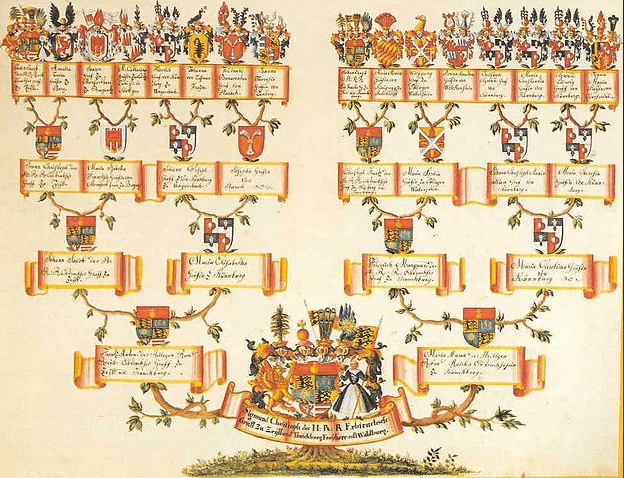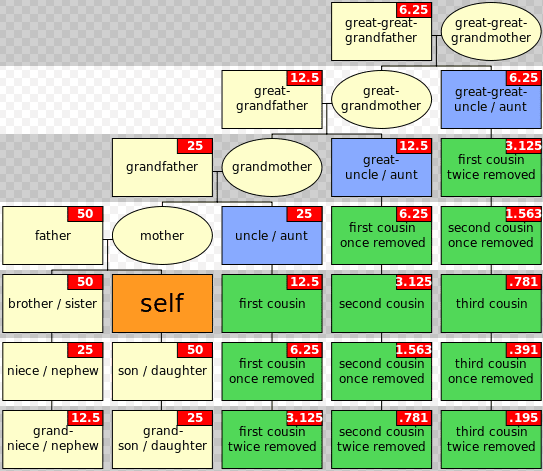What Is the Order of a Family Tree
A family unit tree is an splendid visual tool for exploring your family genealogy. Whether you are retracing your heritage for a school projection or wanting to learn more about your family, researching your family tree history can help you uncover a deeper agreement of who you are and where you came from.

Despite the seemingly elementary concept of the family unit tree, there are specific genealogy and kinship terms that tin can be confusing to empathize when starting your family tree research. With that in mind, we're sharing this guide to explain the different family tree relationships.
Affinal v. Consanguine
When attempting to build anything other than your immediate family tree, you will inevitably run into some new terminology. "Affinal" and "consanguinity" are the two most important of these often-unfamiliar genealogy terms. Understanding their definitions is critical, as they volition have yous down two very dissimilar paths.
- An affinal relationship is a kinship term pregnant "by union." On whatsoever family tree, an affinal relationship is signified past the term "in law."
- Consanguinity is translated direct as "of the same blood," or in other words, a claret relation. Your parents, (great) grandparents, uncles, aunts, brothers, sisters, and cousins of various degrees are all a part of your consanguine family tree.
When exploring your family tree history, it is of import to make the distinction between those to whom yous are leap by marriage and those to whom you are bound by blood. The rest of this guide will exclusively explore the claret relationships. However, you can simply as easily employ many of the kinship terms used for claret relations to your spouse or partner by adding "in law" as a suffix to their title.
Genealogy Terms: The Neat, K, and the Smashing-Dandy Yard
When constructing your family tree, it is essential that you consider the irreplaceable roots without which you would non exist: your parents, their parents, and their parents' parents. Your grandparents tin be the key to correctly placing your uncles, aunts and their children (your offset cousins) into your family tree.
Great-grandparents and neat-neat-grandparents are often harder to trace, connect, and observe a record of, every bit there are many branches of cousins that emanate from them. A great-grandparent is the parent of your grandparent and a great-nifty-grandparent is the parent of your great-grandparent.
Generations earlier great-great usually go by numerical terminology. For example: third cracking-grandparent, fourth great-grandparent, so on. Using this terminology avoids an extended repetition of "great-keen-great-."
The generation gaps that be betwixt great-grandparents (and beyond) and ourselves can often lead to a loss of information and family records. As such, tracing these relatives can assist you observe other ancestors and aggrandize the branches of your family tree.
Cousin Kinship Terms: Degrees and Removed
During family gatherings and your inquiry, you may have heard the phrase "third cousin twice removed" and marveled that anyone could possess such a relation. It's quite common to accept third cousins twice removed, not to mention a whole slurry of other seemingly impossible family tree relationships.

Degrees of Cousins
In that location are a few degrees of relationships with your various cousins to know when information technology comes to your family tree:
- First cousins: those who have the aforementioned grandparents as you but are non your siblings.
- Second cousins: those who only take the same slap-up-grandparents as you.
- Third cousins: those who only have the same keen-bang-up-grandparents as y'all.
The term "removed" is a signifier of how many generations apart y'all are from that specific cousin. For example, your 2nd cousin twice removed is the grandchild of your second cousin, equally they are removed from you by ii generations.
Tabular array of Consanguinity
While agreement and tracing all these relationships can be confusing, a table of consanguinity exists to save us all from the headache of counting our family tree relationships out. The table helps to accept you footstep-by-stride through your relatives, from your great-grandparents to your groovy-grandchildren and everyone in between. Establishing how anybody is connected can aid you lot learn more than virtually your ancestors and trace the different families in your family tree.
What's Next? Build Your Family Tree!
A family tree can get back many generations and aggrandize across many related families. However, tracing every relative and their records to help make full in all the details can be difficult. Memories fade, family unit records are lost, and stories are forgotten. After collecting as much information from your relatives as yous can, utilize online genealogical resources to help you lot larn more than.
Local newspapers published endless stories virtually the people in their communities. Many newspaper articles are the only remaining record of an antecedent. Use GenealogyBank's Historical Newspaper Athenaeum to research and get to know the people behind the names on your family tree.
Source: https://blog.genealogybank.com/genealogy-101-understanding-family-tree-relationships.html
0 Response to "What Is the Order of a Family Tree"
Post a Comment